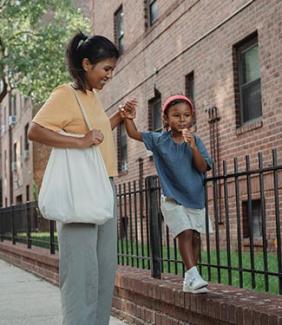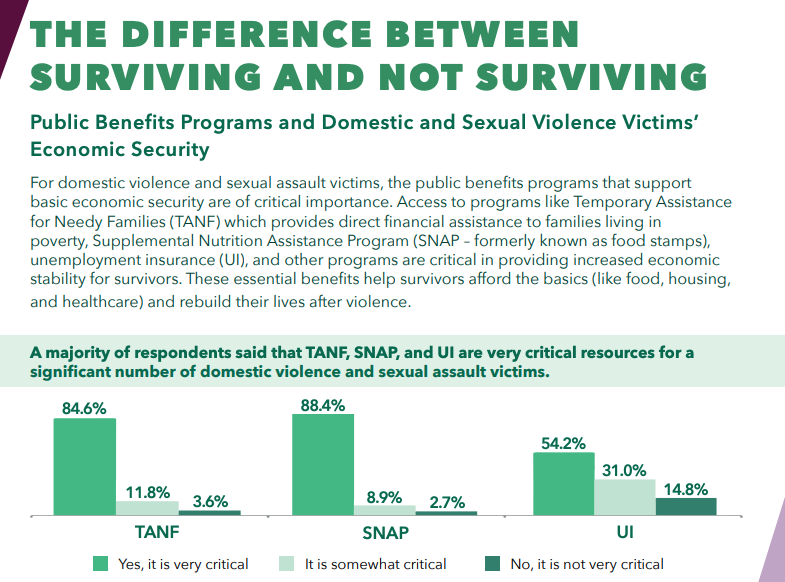By Janet Mickish, PhD, Lead Trainer with Colorado Works, Colorado's Temporary Assistance for Needy Families (TANF) Program
“When I was in an abusive relationship, I was unable to work outside of the home at all. I would have died without public benefits.” – Survivor
Intimate Partner Violence (IPV) and poverty are mutually reinforcing and correlated. IPV can be a pipeline to poverty and, once those impacted by IPV slip into poverty, its tentacles spread into every crevasse of their lives. How does IPV push people down the poverty pipeline? IPV contributes to homelessness, job loss, health problems, and financial difficulties. Temporary Assistance for Needy Families (TANF)’s job is not only to help individuals who are experiencing poverty achieve economic security. This essential public benefit program helps survivors afford the basics and rebuild their lives after violence. TANF’s role is also to work with the community and agencies to stop forces that drive people into poverty.
Navigating the Complexities of TANF to Best Support Survivors
TANF provides life-saving support to tens of thousands of survivors and their families every day. The TANF program, which is time limited, helps families with children provide for their basic needs. States have broad flexibility to carry out their programs. The States, not the Federal government, decide on the design of the program, the type and amount of assistance payments, the range of other services to be provided, and the rules for determining who is eligible for benefits.
To achieve its goals, TANF assistance focuses on helping individuals and families achieve long-term economic security. To accomplish this, TANF screens applicants to determine eligibility. Once accepted into the program, TANF provides basic cash assistance, supportive services like transportation and childcare assistance, utility payments, as well job referrals, behavioral health, and education and training assistance.
TANF mandates that participants engage in certain program requirements, unless there is “good cause” to waive one or more of those requirements. This requires that staff determine whether program participants are a member of a group (e.g., IPV survivor) eligible for waivers. (As a condition of eligibility, each TANF applicant/recipient must cooperate in the determination of paternity and the establishment or enforcement of a support order, unless this requirement is waived for good cause. That is, when cooperating with or establishing a child support order may pose a clear risk to the survivor or the children. A good cause waiver may be granted based upon domestic violence.
It doesn’t end there. Determining that a person is a survivor of IPV is only the second hurdle (the first hurdle was being eligible for TANF). There is a third hurdle, since not all survivors of IPV qualify for one or more of the three Family Violence Option (FVO) waivers: 1) Child Support Services Waiver, 2) Work Activities Waiver, and 3) TANF Time Clock Waiver. Once workers identify individuals as survivors of IPV, workers must assess whether survivors meet waiver criteria.
Instead of increasing TANF staff knowledge, skills, and ability to work with program participants, many TANF agencies require that survivors prove that they have been abused, thus, reinforcing perpetrators’ taunts and threats that “no one will believe you,” “it’s all your fault,” “it’s not that bad,” and “if you get me in trouble, I’ll hurt the children, the children’s’ pets, people you care about, and you.”
Most survivors don’t report even the most egregious violence to law enforcement, clergy, IPV agencies, health care professionals, or even their friends and family for a wide variety of reasons. Chief among those reasons is the perpetrator’s credible threat of increased violence if the survivor reports. That means that most survivors don’t have “proof” or corroboration.
A recent survey found that 53% of survivors report they do not have any “proof” they are a survivor. This means if program participants are required to “prove” what they have experienced in order to receive direct cash assistance—or other services—more than half of survivors would be excluded from support.
The perpetrator’s violence is hurting family members. The family needs help. The survivor is reporting to you, a government agency who is authorized and mandated to help. So, what to do? How can you help without asking survivors to provide proof that may put them and their children at risk of greater harm?
Recommendations for Improving Services
The following are some suggestions and promising practices for TANF workers on how to best support survivors:
- Use language the individual you are serving identifies with. For example, some may prefer “survivor” to “victim” or “participant” to “client.” When in doubt, just ask.
- Implement policies and procedures that include ensuring survivor centered, trauma-informed building and office spaces.
- Require all employees to successfully complete education, training, and skill building activities related to IPV nature and dynamics, survivor-centered and trauma-informed services, IPV screening and assessment, implicit bias, and case management.
- Clarify that screening and assessment, while they may overlap, are separate concepts and processes. Screening may be performed by one worker while assessment may be performed by another employee or committee. It is important to know who is performing which task along with why, how, when, and where they are performing it, what they will do with the information, and next steps.
- Ensure confidentiality. Because many perpetrators ask their children to report survivors’ conversations and actions, consider providing activities for the children in another room when the worker is meeting with a survivor. It is not trauma-informed nor age-appropriate for children to hear these conversations. It is also not appropriate to use the children as interpreters for survivors with limited English proficiency. Screen the survivor at a time and place when the partner is not present.
- Streamline and expedite the application, screening, and assessment processes so that survivors of IPV in crisis do not have to choose between physical safety and economic security.
- Grant FVO waivers to survivors of IPV.
- The Child Support Services Waiver enables the survivor to be accepted as a TANF participant without being referred to Child Support Services that would contact the perpetrator who may escalate violence.
- The Work Activities Waiver waives some or all work requirements so survivors can seek safety, obtain advocacy services from IPV programs, find safe housing, heal from injuries, or other things that increase the survivor’s ability to recover from the violence and move toward economic security.
- The TANF Time Clock Waiver enables survivors to continue receiving TANF benefits beyond the time limit if domestic violence is still interfering with their ability to become economically secure and they meet all other program requirements.
- Grant waivers to survivors who may not be in immediate danger. IPV can have a long-term impact that may limit a survivor’s ability to participate in program activities. Some of the IPV effects are short term and disappear when the survivor gains a sense of safety and success. Other effects may last a lifetime. Some effects include, but are not limited to depression, anxiety attacks, PTSD, substance abuse issues, traumatic brain injury, gynecological problems, asthma, chronic pain, heart problems, migraine headaches, memory loss, and difficulty concentrating.
- Don’t re-victimize the survivor by over-verifying. Train all staff to understand what IPV looks like – its red flags, patterns, cycles, key perpetrator tactics, and trauma as well as survivors’ adaptations, reactions, pro-actions, and responses to abuse. Accept “survivor statement” as verification and use the “Prudent Person Principle.”
Cross-Training and Collaboration
Education and training require more than a short video or reading an article; it requires meaningful collaboration with IPV programs through ongoing training, discussions, interaction, practice, and review.
- Implement true collaboration and cross-training between IPV programs and TANF agencies.
- IPV agencies include those focusing on survivors and their children as well as evidence-based perpetrator treatment.
- “Co-locate” IPV advocates with the TANF agency and ensure there is a secure, private space to discuss issues with survivors.
- Assign a TANF worker to work at the site for an IPV program to discuss TANF and enroll and/or provide TANF case management to IPV program participants.
- Develop policies, protocols, and wrap-around services for and in consultation about survivors.
- Collaboratively develop realistic safety plans with survivors.
- Collaborate with childcare agencies to ensure appropriate resources for children impacted by IPV.
- Collaborate with mental and behavioral health agencies to re-name services to reflect support and enrichment rather than problems. For instance, some cultures reject the idea of “mental health services” or “counseling.” Also, many IPV perpetrators’ tactics include telling the survivor that “you are crazy,” “you have a mental health problem,” “you’re mentally ill.” Perpetrators also commonly use “gaslighting” (e.g. “I never said that,” “you didn’t see that,” “you’re making that up,” “you are turning the kids against me”). Referring a survivor to something called counseling or mental health services legitimates perpetrators’ tactics. What to do? Work with agencies to change the names of their programs (for example, “Relationship Empowerment,” “Employment Leadership” or “Leading Through Parenting”).
- Work with program participants to develop individualized, survivor-centered, employment-focused plans supported by case managers/coaches with a goal of long-term economic security. Waive program requirements where appropriate so that survivors can achieve economic security at a pace that is right for them.
- Collaborate with animal welfare agencies, veterinarians, animal rescue organizations, etc., to safeguard pets and livestock so survivors know that the perpetrator can’t hurt (or continue to hurt) the animals.
 Build collaborative relationships with local and state bar associations and other legal assistance agencies so referrals can be effective and efficient.
Build collaborative relationships with local and state bar associations and other legal assistance agencies so referrals can be effective and efficient.- Implement the TANF supported options for participants to establish savings to further education, start a business or purchase a home.
- Collaborate with Child Support Services to provide 100% pass through for child support collected through Child Support Services. Also, work with Child Support Services to provide a safe option for survivors who want to collect child support. This means redacting key information such as address, phone number, social security number, and employment information from child support requests the agency sends to the non-custodial parent.
- Collaborate with Address Confidentiality Programs to ensure that survivors receive information about the program and that designated TANF staff are trained to administer the program within agency.
- Because survivors of IPV may face unique challenges due to structural racism and other societal inequities, it is helpful when TANF agencies collaborate with agencies that serve specific populations within their service area to ensure that policies, procedures, programs, staffing, language, etc., represent and serve the public. Some of the populations that may benefit from interagency collaboration may include refugees, LGBQ+, Latinx, Black, Native, and people with disabilities – populations which have been historically marginalized. Interagency collaboration should also address Anti-Black racism, white supremacy and other “isms” embedded within their practices and policies so that these populations are not further silenced and pushed to the margins.
- Collaborate with child welfare and criminal justice agencies to develop supportive referrals and resources. Some survivors may be involved with child welfare, or criminal justice agencies as well as TANF, and coordinated services can decrease contradictory requirements, duplications, and increase the probability of participants achieving economic security.
Editor’s Notes:
It’s important to keep in mind that survivors in traditionally marginalized communities, such as Black people, Indigenous people, and other person(s) of color, disproportionately experience poverty, food and housing insecurity, unstable and low-wage employment, and other forms of economic disadvantage. This is the result of structural racism and other oppressive systems such as ableism, transphobia, and xenophobia, just to name a few. Access to economic security programs like TANF – which provides direct financial assistance to families living in poverty – is critical in providing increased economic stability for survivors, especially those most marginalized. This and other essential public benefits programs enable survivors to afford the basics like food, housing, and healthcare and help rebuild their lives after violence.
That said, it is also critical that public benefits programs at the federal and state levels be strengthened to improve access and support for survivors. Currently, eligibility barriers to TANF benefits present a serious safety challenge for some survivors. For instance, most immigrants lawfully residing in the United States are barred, under federal law, from receiving assistance under the major public benefits programs for five years or longer. Additionally, even if immigrant survivors or their children are eligible to receive benefits, many are not applying for these programs for fear of deportation, detention or other negative consequences. The reports, The Difference Between Surviving and Not Surviving and We Would Have Had to Stay offer recommendations to reduce barriers for accessing TANF and other benefits. Strategies are also included to strengthen practices, programs, and policies that foster safety and economic security for all survivors and their families.
“For people who need them, it is very important for their well-being, for health, sanity, and to survive.” – Survivor
For more information:
The Difference Between Surviving and Not Surviving: Public Benefits Programs and Domestic and Sexual Violence Victims' Economic Security – This report discusses the findings from a 2017 survey of over 1,100 domestic and sexual violence advocates, legal services/legal aid providers, social services program staff, and housing/homelessness and anti-poverty advocates. It details barriers survivors encounter when trying to access public benefits programs, cross-sector collaboration and systems-level advocacy, and possible legislative changes to these critical programs.
NRCDV Radio Podcast: The Difference Between Surviving & Not Surviving – NRCDV Radio asked Shania Goodman, author of “The Difference Between Surviving and Not Surviving” to explore the role that public benefits can play in addressing economic insecurity among domestic violence victims, and how public benefit programs can be strengthened.
We Would Have Had to Stay: Survivors' Economic Security and Access to Public Benefits Programs – This report shares findings from a survey of 289 domestic violence survivors who contacted the National Domestic Violence Hotline in 2017. The survey covered experiences of economic instability, the importance of benefits, applying for benefits and barriers to applying, screening and disclosure of abuse, and loss of benefits.
Intimate Partner Violence in the time of COVID-19: TANF’s Vital Role in Prevention – On this webinar hosted by the Office of Family Assistance, a subject matter expert and a TANF program practitioner shared insights and recommendations for leveraging TANF to provide support to intimate partner violence (IPV) survivors during COVID-19 and beyond.
Survivors Know Best: How to Disrupt Intimate Partner Violence During COVID-19 and Beyond – This report collected data from 1,300 survivors in 36 states and Puerto Rico on their financial health, the financial cost of experiencing abuse, what their needs are right now, and how our society can best support them through the COVID-19 pandemic and beyond.
Trust Survivors: Building an Effective and Inclusive Cash Assistance Program – In this report, FreeFrom shares what they learned from 1,000 survivors who received a Safety Fund grant in 2020 about how to build an effective and inclusive cash assistance program that will meet survivor’s needs. Overwhelmingly, survivors expressed that they need a program steeped in flexibility and trust.
*While this TAQ is directly addressing TANF workers at government agencies, the guidance and resources shared within are also vital to IPV advocates. Developing ongoing and meaningful relationships between advocates and TANF workers is critical towards removing barriers and strengthening public benefits programs so that they best meet the needs of survivors.















